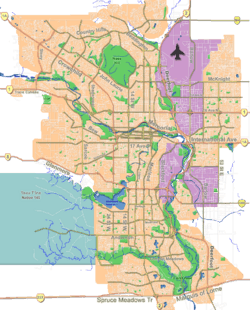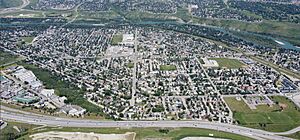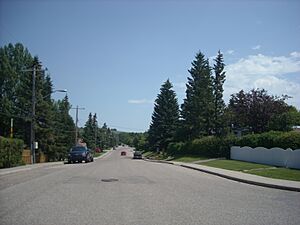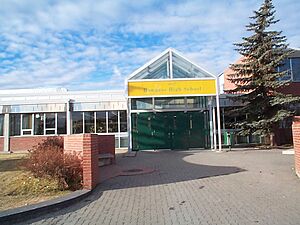Bowness, Calgary facts for kids
Quick facts for kids
Bowness
|
|
|---|---|
|
Neighbourhood
|
|

Aerial view of Bowness
|
|
| Country | Canada |
| Province | Alberta |
| City | Calgary |
| Quadrant | NW |
| Ward | 1 |
| Established | 1896 |
| Village | February 14, 1948 |
| Town | November 5, 1951 |
| Amalgamated | August 15, 1964 |
| Elevation | 1,080 m (3,540 ft) |
| Population
(2008)
|
|
| • Total | 11,308 |
| • Average Income | $40,468 |
| Website | Bowness Community Association |
Bowness is a lively neighbourhood in west Calgary, Alberta, Canada. It used to be its own town. In 1964, Bowness joined the City of Calgary. This process is called amalgamation, which means two areas combine to form one larger city.
Bowness is surrounded by the Bow River to the north and east. It is bordered by 16 Avenue to the south and Stoney Trail to the west. The neighbourhood of Montgomery is just across the river to the east. Montgomery also joined Calgary a year earlier, in 1963.
One of Calgary's most popular spots, Bowness Park, is in the northwest part of Bowness. This park is great for picnics and summer sports. In winter, people love to go ice skating and boating there. It's also connected to Calgary's big network of walking and biking paths.
Bowness is looked after by a city councillor from Ward 1. People who live in Bowness are sometimes called "Bownesians."
Contents
A Look Back: Bowness History
How Bowness Began
The Bow Valley, where Bowness is located, has been home to Indigenous peoples for a very long time. Archeologists have found signs that the Nitsitapii (Blackfoot) lived here over a thousand years ago. Later, Stoney, Cree, and Tsuu T'ina peoples also arrived.
In the late 1700s, non-Indigenous people started coming to the area. Sadly, this led to a big drop in Indigenous populations due to sickness and the loss of bison herds. In 1877, several First Nations signed Treaty 7. This meant they had to live on reserves, which were smaller areas of their traditional lands.
Around the same time, land surveys made it easier to sell land in western Canada. The area that became Bowness was first leased by the Cochrane Ranche Company in 1883. Over the next few decades, the land was bought and sold many times.
Two important sales shaped Bowness. In 1890–91, Thomas Stone and Jasper M. Richardson bought the land. They started the Bowness Ranche. Its stables were on an island in the river, which is now Bowness Park. Stone named the area "Bowness" because he liked visiting Bowness-on-Windermere in England.
John Hextall's Vision
In 1908, John Hextall, a lawyer from England, bought the land. Calgary was growing fast, and Hextall wanted to create a fancy neighbourhood in Bowness. He imagined it as a beautiful place with natural scenery.
In 1911, he divided part of the ranch into lots for homes. He even paid $75,000 to build a bridge. He also convinced the City of Calgary to extend its streetcar line across his new bridge into his development. He called it Bowness Estates. In return, he gave two islands on the Bow River to the City to become a park. This park is what we know today as Bowness Park.
Even with lots of advertising and new features like a golf course, not many lots were sold. The economy slowed down, and then World War I started in 1914. Hextall himself passed away that same year.
After the war, Bowness didn't grow much. However, Bowness Park became very popular. Thousands of Calgarians would ride the streetcar to visit. Some small farms started up, and enough people moved in to build a school in 1932. Stores and a post office followed in 1934.
Marty Wood, a famous rodeo cowboy, moved to Bowness with his family around 1940. His parents opened riding stables. Also, a large field near the park, called the Bowness Flying Field, was Calgary's first commercial airport. A Canadian flying hero, Fred McCall, managed it. He often flew sightseeing trips to Banff in the 1920s.
Bowness started to grow again after World War II. The government gave 48 plots of land to soldiers returning from the war. This area was known as the Soldiers' Settlement. More schools and churches were built. In 1947, two movie theaters opened for the growing population. A volunteer fire department was formed, and other public services were added.
Becoming Part of Calgary
| Population history, former Town of Bowness |
||
|---|---|---|
| Year | Pop. | ±% |
| 1951 | 2,922 | — |
| 1956 | 6,217 | +112.8% |
| 1961 | 9,184 | +47.7% |
| Source: Statistics Canada | ||
Bowness officially became a village on February 14, 1948. Its population grew to 2,922 by 1951. Because of this growth, Bowness became a town on November 5, 1951. John Mackintosh was elected as the first mayor of the Town of Bowness in March 1952.
Bowness continued to grow quickly. By 1956, its population had more than doubled to 6,217. In 1961, it reached 9,184 people. The nearby Town of Montgomery joined Calgary in 1963. After this, Bowness residents voted in October 1963 on whether to join Calgary too. Most people voted yes. So, the Town of Bowness officially became part of the City of Calgary on August 15, 1964.
Bowness Today
Since joining Calgary, Bowness has faced some changes. It's a unique community because it used to be separate. Bowness has a mix of residents, including both wealthy and less wealthy families. This mix makes it different from many newer Calgary neighbourhoods.
Like many older parts of Calgary, Bowness is seeing some updates. Many homes and businesses are being renovated or rebuilt. For example, between 2006 and 2010, the shops along "Main Street" Bowness were updated. This included the old Bowness Hotel, now called Hextall Place. The former Bow Cycle Building now holds the Calgary Public Library.
Bowness also hosts several fun yearly events:
- The Lions Club Stampede Parade and Breakfast happens on the first weekend of the Calgary Stampede.
- The Tour de Bowness is a cycling event held at the end of July.
- The Harvest Fair takes place on the second weekend in September.
Education in Bowness
Most public high school students from Bowness attend Bowness High School. This school was built before Bowness joined Calgary.
Other schools in the community include:
- Thomas B. Riley Junior High
- Belvedere Parkway Elementary
- Bowcroft Elementary
There is also one Catholic school for students from Kindergarten to Grade 9, called Our Lady of the Assumption.





